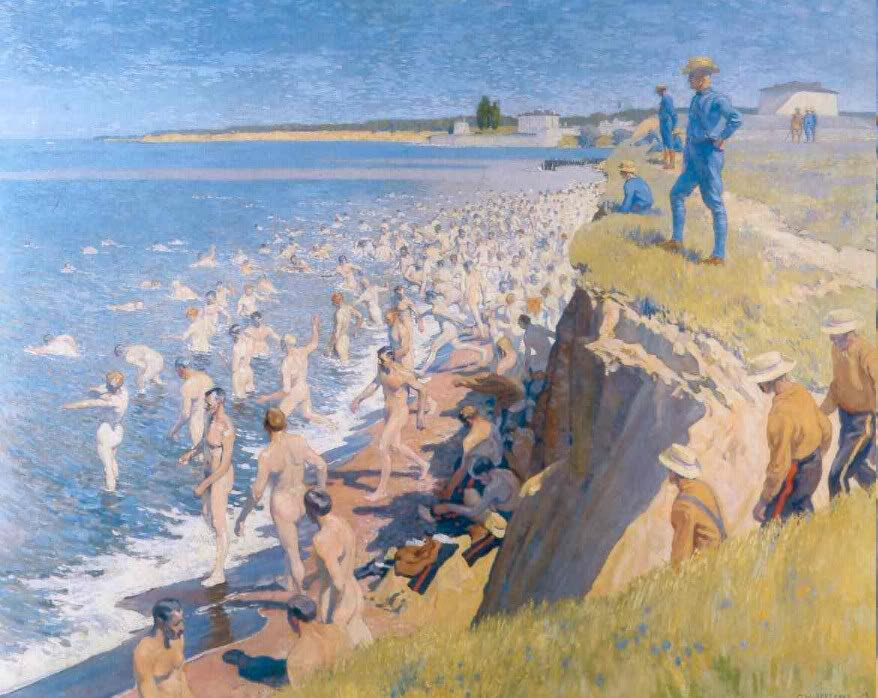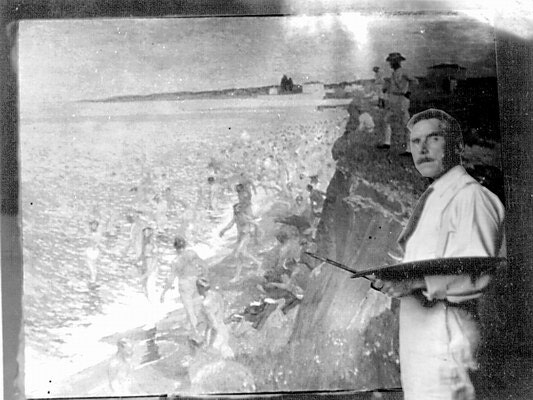Polish Army at Beach
1918
Oil on canvas
Height 152.0 cm, Width 193.0 cm
Beaverbrook Collection of War Art Canadian War Museum Artifact #19710261-0205
Inscription (recto) C.W. Jefferys 19; (plaque): POLISH ARMY BATHING AT NIAGARA CAMP L'ARMÉE POLONAISE SE
Exhibition History
Remarks
Jefferys worked for Canadian War Records in 1918, recording the activities Polish Army in Exile at Niagara and Toronto and the Siberian Army in Exile in at Camp Petawawa, Ontario.
Publication References
-
“Academy and freak ‘art’.” In Evening Telegram, Nov. 22, 1923, p. 36. “No. 87, C.W. Jefferys water-color study of the Polish regiment bathing at Niagara, is worthy of attention…”
- National Gallery of Canada. Exhibition of Canadian painting by a group of selected artists. Ottawa, The Gallery, 1935. 25 p. Illus.
- Hubbard, R.H. The National Gallery of Canada, Catalogue of paintings and sculpture: volume III, Canadian school. Ottawa, The Gallery, 1960. 463 p. Illus.
- Merritt, Richard D. On Common Ground: The Ongoing Story of the Commons in Niagara-on-the-Lake. Toronto, Dundurn, 2012. 320p. Illus.
-
The Book of lists: revised and updated and even more Canadian…the Canada 150 edition. Toronto, Knopf, 2017. 496 p. p. 69 - “The wartime body—the mutilated male corpse in particular—is a reminder of both the hell of war and the banality of evil. With the Canadian-initiated development of the first official war art program in the early 20th century, artists suddenly gained broader and more intimate access to depicting this potent signifier. Although corpses didn’t stop piling up on battlefields, as C.W. Jefferys’s 1919 Polish Army Bathing at Niagara Camp and George Pepper’s 1944 Mobile Bath (both at the Canadian War Museum) show, Canadian artists also began shining a new light on another sort of military body. Of course, what makes images such as these so powerful is not only their brazen sexual
undercurrent, but the utter incongruity of the scenario they represent—namely, the bathing of bodies used for slaughter.”p. 472 - “Index…Jefferys, C.W., 69…”
Websites
-
“Sites of the First World War – War Heritage / Patrimoine de La Guerre.” 2017. Accessed February 9. http://warheritage.royalroads.ca/war-memories-across-canada/world-war-i/.In 1917, 22,000 Polish volunteers came to Niagara-on-the-Lake in Ontario to train for the First World War. Although the men were destined to join the French army once in Europe, Canada’s role was to prepare them for battle. A painting depicts a poignant scene of life on Niagara Lake.





Comments